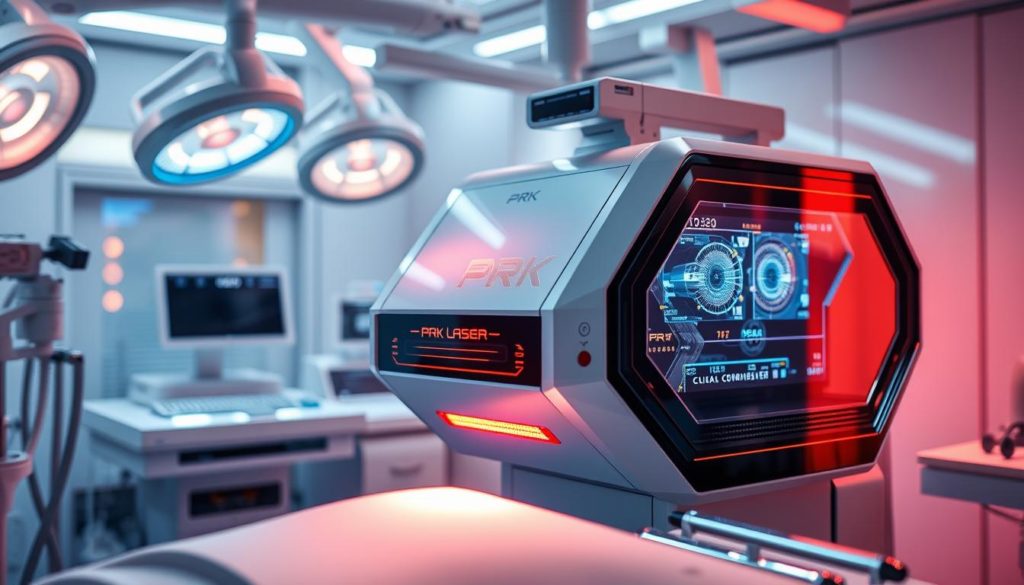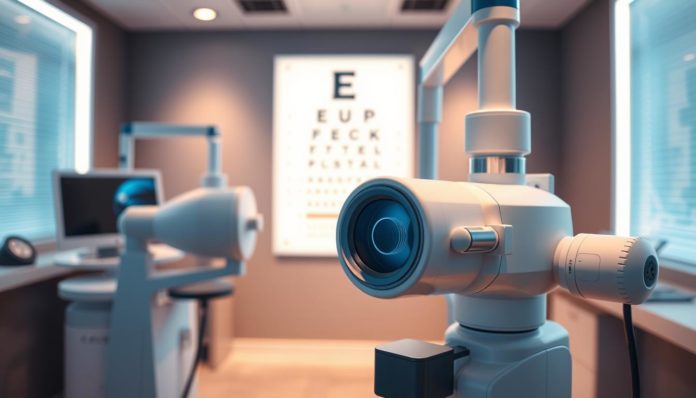Did you know over 10 million people worldwide have had PRK surgery by 2023? This advanced laser eye surgery has been improving vision for decades. It’s a great option for those tired of glasses or contacts.
Our guide will walk you through PRK surgery. You’ll learn about its benefits and possible side effects. It’s all about understanding PRK vision correction.
This guide is your ultimate resource on PRK surgery. We’ll explore every detail of PRK. Find out if PRK is the answer you’ve been looking for in laser eye surgery.
What is Photorefractive Keratectomy (PRK)?
Photorefractive Keratectomy (PRK) is a surgery that fixes vision problems like nearsightedness, farsightedness, and astigmatism. It works by taking off the top layer of the cornea and then reshaping it with a special laser. This method is great for people with thin corneas or other LASIK issues.
By changing the shape of the cornea, PRK helps light focus better on the retina. This leads to clearer vision.

How PRK Works
An eye doctor starts by removing the top layer of the cornea. Then, a laser reshapes the layer underneath. This reshaping makes the cornea focus light better on the retina, which is key for sharp vision.
The top layer grows back in a few days after surgery.
History of PRK Surgery
PRK surgery began in the late 1980s as the first laser surgery for vision correction. It was created by researchers and eye doctors. They wanted to offer a new option besides glasses and contacts.
Over time, better laser technology has made PRK safer and more effective. Now, it’s a popular choice for many.
Conditions Treated by PRK
PRK can fix several vision problems, including:
- Myopia (nearsightedness): Trouble seeing far-off things.
- Hyperopia (farsightedness): Trouble seeing close things.
- Astigmatism: Blurry vision due to a cornea or lens that’s not round.
These issues can make everyday tasks hard. PRK offers a lasting fix, improving vision and life quality.
Benefits of PRK Surgery
Photorefractive Keratectomy (PRK) is a great option for those looking into laser eye surgery. It’s especially good for people with thin corneas, which is a plus. This makes PRK a flexible choice for more patients.

One big plus is that PRK doesn’t have flap problems. Unlike LASIK, PRK doesn’t cut the cornea. This means less chance of flap issues or infections. This leads to more reliable results.
PRK also offers long-lasting vision correction. This can greatly improve a person’s life. It’s a lasting fix for vision problems.
Another benefit is it’s better for those with dry eyes. PRK doesn’t make dry eyes worse, unlike LASIK. This makes it a safer choice for people with dry eye issues.
To wrap up, let’s look at some key differences between PRK and other laser surgeries:
| Benefit | PRK | Other Laser Surgeries |
|---|---|---|
| Suitability for Thin Corneas | Yes | Limited |
| No Flap Complications | Yes | No |
| Long-term Vision Correction | Yes | Yes |
| Reduced Dry Eye Risk | Yes | No |
In summary, PRK is a strong choice for many. It offers great results and is a solid solution for vision problems.
PRK Procedure Explained
The journey of PRK surgery involves several key steps. A detailed PRK patient guide helps keep patients comfortable and ensures the best results.
Pre-surgery Preparation
Getting ready for PRK surgery is very important. Before the surgery, patients have consultations with their ophthalmologist. The doctor checks their eye health and medical history.
During these meetings, patients learn important guidelines. They must stop wearing contact lenses a few weeks before. They also need to avoid makeup on the day of the surgery. These steps are key to a successful surgery.
During the PRK Surgery
Knowing what happens during PRK surgery can help reduce anxiety. The ophthalmologist carefully removes the outer layer of the cornea, called the epithelium. Then, an excimer laser reshapes the corneal tissue to fix vision problems.
The whole process usually takes less than 15 minutes per eye. Most of this time is spent on precise measurements and laser adjustments.
Post-surgery Care
After PRK surgery, taking care of your eyes is crucial. Patients wear protective lenses for a few days to help the cornea heal. They might feel some discomfort or see blurry, but this usually gets better in a few days.
It’s important to take all prescribed medications and go to follow-up appointments. Avoiding hard activities, swimming, and direct sun is also recommended. Following these steps closely ensures a smooth recovery and clear vision.
By carefully following these steps, from the first consultation to the aftercare, patients can get the best results from their surgery.
Potential PRK Side Effects
Photorefractive Keratectomy (PRK) is a common surgery for vision problems. But, it’s important to know about possible side effects. Right after the surgery, some people might feel mild discomfort. They might also experience itching, dryness, or feel like something is in their eye.
Some people might see halos, glare, or have trouble seeing at night. These issues are rare but can be a worry for those with specific vision needs. Luckily, they usually get better with time.
PRK might take longer to heal than LASIK. The corneal surface needs time to fully recover. This can be a bit scary, but it’s a normal part of the healing process.
It’s important to know about the risks of laser surgery. Though rare, infections can happen if you don’t follow care instructions well. Staying clean and using antibiotic drops as directed can help avoid this risk.
- Discomfort: Itching, dryness, or a foreign body sensation.
- Visual Disturbances: Halos, glare, or night vision issues.
- Recovery Time: Longer healing period compared to LASIK.
- Infections: Rare but preventable with proper care.
Even with possible side effects, PRK can still be a good choice. Talking to your eye doctor about PRK can help you understand how to deal with these risks. Doing your research and being prepared is crucial for a successful vision correction journey.
PRK Recovery Time: What to Expect
Recovery time after PRK surgery is key for those considering it. Knowing the PRK healing process helps set realistic expectations. It also reassures patients about what’s to come.
Immediate Post-Surgery
Right after PRK surgery, you might feel some discomfort, see blurry, and be sensitive to light. These are normal symptoms in the early stages of eye surgery healing. You can use over-the-counter pain relievers and eye drops as prescribed. It’s important to follow your surgeon’s advice to avoid infections.
First Few Weeks
In the first few weeks, your vision will slowly get better. You might still see blurry and experience some changes. Most people can go back to work in a week. However, it’s best to avoid hard work and wear protective eyewear to shield your eyes from bright lights and irritants.
Long-term Recovery
The long-term recovery phase is when your vision stabilizes. You’ll see gradual improvements over several months. Keeping up with follow-up appointments is crucial. This helps track your progress and address any post-PRK timeline concerns. By six months, most people see clear and stable vision, marking the end of the eye surgery healing.
| Phase | Timeline | Symptoms | Care Tips |
|---|---|---|---|
| Immediate Post-Surgery | First 24-48 hours | Blurred vision, discomfort, light sensitivity | Use prescribed eye drops, avoid rubbing eyes |
| First Few Weeks | 1-4 weeks | Fluctuating vision, mild discomfort | Wear protective eyewear, avoid strenuous activities |
| Long-term Recovery | 3-6 months | Gradual vision stabilization | Attend follow-up appointments, report any concerns |
PRK vs LASIK: Which is Better?
Choosing between PRK or LASIK for the best vision correction can be tough. Both are popular laser eye surgeries. But, each has its own features that might fit better with different needs.
Key Differences
PRK and LASIK both use lasers to fix vision problems. But, they do it in different ways. LASIK makes a flap on the cornea to get to the tissue underneath. PRK removes the outer layer of the cornea and then reshapes it.
This difference affects how long it takes to recover, how much pain you might feel, and who can get the surgery.
Pros and Cons of Each
There are good and bad points for PRK and LASIK:
| Procedure | Pros | Cons |
|---|---|---|
| PRK |
|
|
| LASIK |
|
|
Suitability for Different Eye Conditions
Choosing the right laser eye surgery depends on your eye condition. PRK might be better for those with thinner corneas or who play high-impact sports. It’s because there’s no flap involved.
LASIK is often chosen by those who want quick recovery and less discomfort after surgery.
Cost of PRK Surgery
Thinking about PRK surgery means looking at its cost. Financial planning for PRK is key. The price can change a lot because of different things.
Factors Influencing Cost
The PRK surgery price is influenced by several things:
- The technology used, like advanced lasers
- The surgeon’s experience and reputation
- Where you live, with cities often being pricier
These factors can make the surgery more expensive. This affects how easy it is for people to afford laser eye surgery.
Insurance and Financing Options
Many insurance plans don’t cover PRK, but some might for certain cases. It’s crucial to check with your insurance.
There are also ways to pay for PRK surgery. Clinics often have payment plans. This makes laser eye surgery more affordable.
Looking into these options can help. It lets you get clearer vision without a huge upfront cost.
Choosing the Right Surgeon for PRK
Choosing the right surgeon for your PRK surgery is crucial. It’s a decision that should be made carefully. Look for a surgeon with the right qualifications and experience.
Start by checking their credentials and expertise. Choose an ophthalmologist who has been trained well and has a lot of PRK surgery experience. Make sure they are certified by the American Board of Ophthalmology.
Meeting the surgeon directly is a great way to learn more. Ask them about their experience, success rates, and how many PRK surgeries they’ve done. Also, ask for testimonials or photos from past patients. This can give you a better idea of their skills and how they treat patients.
Feeling confident in your surgeon’s abilities is important. It can make you feel more at ease and improve your surgery’s success. By doing your research and finding a qualified surgeon, you’re more likely to have a good experience. Making an informed choice can lead to better results for your vision.
FAQ
What is Photorefractive Keratectomy (PRK) surgery?
PRK is a laser eye surgery. It corrects vision problems like myopia and astigmatism. It reshapes the cornea.
How does PRK differ from LASIK?
PRK and LASIK both use lasers to reshape the cornea. But PRK doesn’t create a corneal flap. This makes it better for those with thinner corneas. PRK’s recovery is longer than LASIK’s.
What can I expect during PRK recovery time?
Right after PRK, you might feel some discomfort and see things blurry. Your vision will get clearer over time. Most people see best in a few months.
Are there any potential PRK side effects?
Yes, you might experience dry eyes, glare, and halos. These usually go away in a few weeks or months. Serious problems are rare.
How much does PRK surgery typically cost?
PRK costs between
FAQ
What is Photorefractive Keratectomy (PRK) surgery?
PRK is a laser eye surgery. It corrects vision problems like myopia and astigmatism. It reshapes the cornea.
How does PRK differ from LASIK?
PRK and LASIK both use lasers to reshape the cornea. But PRK doesn’t create a corneal flap. This makes it better for those with thinner corneas. PRK’s recovery is longer than LASIK’s.
What can I expect during PRK recovery time?
Right after PRK, you might feel some discomfort and see things blurry. Your vision will get clearer over time. Most people see best in a few months.
Are there any potential PRK side effects?
Yes, you might experience dry eyes, glare, and halos. These usually go away in a few weeks or months. Serious problems are rare.
How much does PRK surgery typically cost?
PRK costs between $1,500 and $3,000 per eye. Prices vary based on the surgeon, technology, and location. Some insurance might help cover it.
Is PRK surgery painful?
The surgery itself isn’t painful because of numbing drops. But, you might feel some discomfort when you’re recovering.
How do I prepare for PRK surgery?
First, get a full eye exam. Stop wearing contact lenses if you have them. Follow your ophthalmologist’s pre-op instructions carefully.
What are the benefits of PRK surgery?
PRK has no flap complications. It’s good for people with thinner corneas. It can also correct vision for a long time.
Who is a good candidate for PRK surgery?
Good candidates are over 18, have stable vision for a year, and healthy corneas. They should not have eye diseases. A thorough check by an ophthalmologist is key.
How long has PRK been in use?
PRK has been around since the late 1980s. It’s the older cousin of LASIK. Its long history makes it reliable and effective.
What should I consider when choosing a PRK surgeon?
Choose a board-certified ophthalmologist with lots of PRK experience. Look at patient reviews and ask about success rates. Discuss any worries during your visit.
Can I drive myself home after PRK surgery?
No, you’ll need someone to drive you home because your vision will be blurry. Take a few days off work too.
,500 and ,000 per eye. Prices vary based on the surgeon, technology, and location. Some insurance might help cover it.
Is PRK surgery painful?
The surgery itself isn’t painful because of numbing drops. But, you might feel some discomfort when you’re recovering.
How do I prepare for PRK surgery?
First, get a full eye exam. Stop wearing contact lenses if you have them. Follow your ophthalmologist’s pre-op instructions carefully.
What are the benefits of PRK surgery?
PRK has no flap complications. It’s good for people with thinner corneas. It can also correct vision for a long time.
Who is a good candidate for PRK surgery?
Good candidates are over 18, have stable vision for a year, and healthy corneas. They should not have eye diseases. A thorough check by an ophthalmologist is key.
How long has PRK been in use?
PRK has been around since the late 1980s. It’s the older cousin of LASIK. Its long history makes it reliable and effective.
What should I consider when choosing a PRK surgeon?
Choose a board-certified ophthalmologist with lots of PRK experience. Look at patient reviews and ask about success rates. Discuss any worries during your visit.
Can I drive myself home after PRK surgery?
No, you’ll need someone to drive you home because your vision will be blurry. Take a few days off work too.


